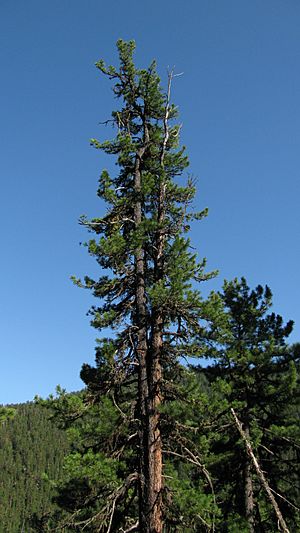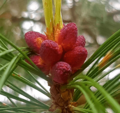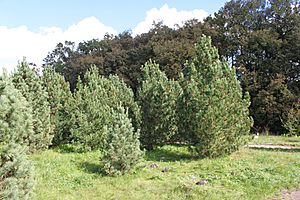Siberian pine facts for kids
Quick facts for kids Siberian pinePinus sibirica |
|
|---|---|
 |
|
| Conservation status | |
| Scientific classification | |
| Genus: |
Pinus
|
| Species: |
sibirica
|
| Synonyms | |
|
|
The Siberian pine, also known as Pinus sibirica, is a type of pine tree. It belongs to the Pinaceae family. You can find these trees growing across Siberia. They stretch from the Ural Mountains in the west to the Stanovoy Range in the east. They also grow from Igarka in the north down to central Mongolia in the south.
Contents
About Siberian Pine
Siberian pine is part of the white pine group. Like other trees in this group, its leaves are called 'needles'. These needles grow in small groups of five. Each group has a cover that falls off. The needles are usually 5 to 10 centimeters long.
Cones and Seeds
The cones of the Siberian pine are about 5 to 9 centimeters long. Inside these cones are the seeds. The seeds are 9 to 12 millimeters long. They have a very small wing. Spotted nutcrackers, which are birds, help spread these seeds.
Siberian Pine vs. Swiss Pine
Some scientists think Siberian pine is a type of Swiss pine. These two trees look very similar. Siberian pine has slightly bigger cones. Its needles also have three resin canals. Swiss pine needles only have two.
Fighting Tree Diseases
Siberian pine is strong against a disease called white pine blister rust. This is a fungal disease. It came to North America from Europe by accident. It has harmed many native white pines there. For example, it has badly damaged the whitebark pine. Siberian pine is very important for research. Scientists hope to use it to make other pine trees resistant to this rust.
Where Siberian Pine Grows
In the northern parts of its home, Siberian pine grows in lower areas. It is usually found at heights of 100 to 200 meters. Further south, it becomes a mountain tree. There, it grows at much higher altitudes, from 1,000 to 2,400 meters. It often reaches the alpine tree line in these mountain regions.
A grown Siberian pine can be 30 to 40 meters tall. Its trunk can be up to 1.5 meters wide. These trees can live for a very long time. Some have lived for 800 to 850 years!
Growing Siberian Pine
Siberian pine is a popular ornamental tree. People like to plant it in parks and big gardens. It grows well in places with cold climates, like central Canada. It grows steadily, though not quickly. It can grow in many different kinds of places.
This tree can handle very cold winters. It can survive temperatures as low as –60 °C. It also does well in windy spots.
The seeds of the Siberian pine are collected. They are sold as pine nuts. In Russia, these nuts are called Cedar nuts (Russian: Кедровые орехи).
"Siberian Cedar" Name
In Russian, the name for this tree is Сибирский кедр. This usually gets translated into English as “Siberian cedar.” But when you see "cedar" in texts translated from Russian, it usually means this pine tree or other related pines. It does not mean a true cedar tree.
Images for kids
See also
 In Spanish: Pinus sibirica para niños
In Spanish: Pinus sibirica para niños









